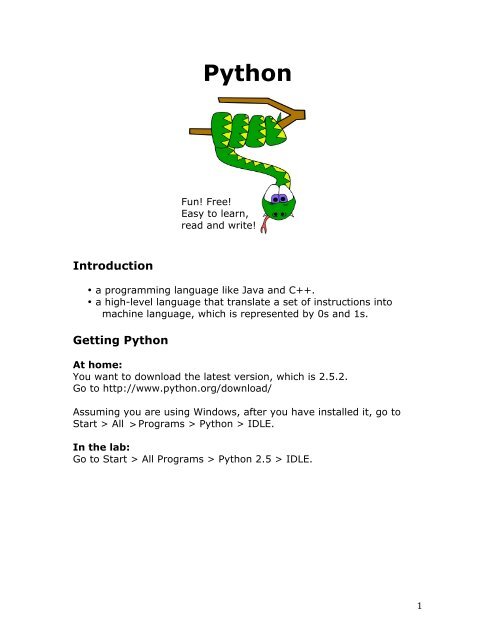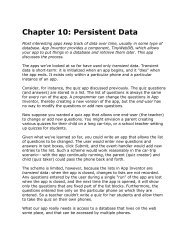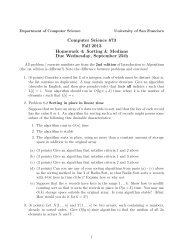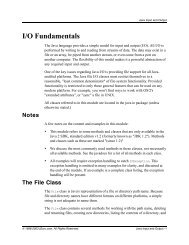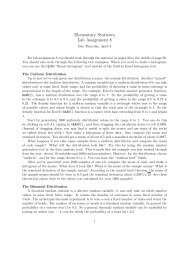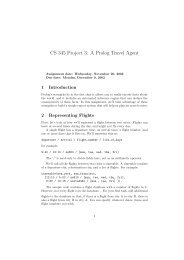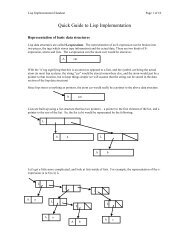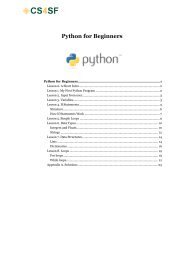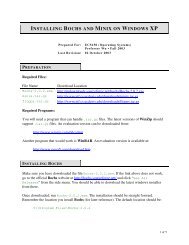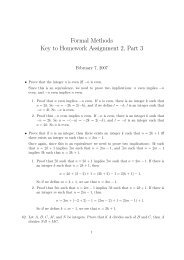Python Worksheets - Computer Science
Python Worksheets - Computer Science
Python Worksheets - Computer Science
You also want an ePaper? Increase the reach of your titles
YUMPU automatically turns print PDFs into web optimized ePapers that Google loves.
<strong>Python</strong> !"#$%&<br />
!!!!!!!!!!!!!!!!!!!!!!!!!!!!!!!!!!!!!!!!!!!!!<br />
!!!!!!!!!!!!!!!!!!!!!!!!!!!!!!!!!!!!!!!"#$%!"&''%<br />
!!!!!!!!!!!!!!!!!!!!!!!!!!!!!!!!!!!!!!!()*+!,-!.')&$/<br />
!!!!!!!!!!!!!!!!!!!!!!!!!!!!!!!!!!!!!!!&')0!)$0!1&2,'%<br />
Introduction<br />
'&#(%)*+#,%&<br />
• a programming language like Java and C++.<br />
! )!3&-4&)552$4!.)$4#)4'!.26'!7)8)!)$0!9::;<br />
• a high-level language that translate a set of instructions into<br />
! )! All > Programs > <strong>Python</strong> > IDLE.<br />
I**#52$4!+-#!)&'!#*2$4!J2$0-1*/!)>,'&!+-#! <strong>Python</strong> 2.5 > IDLE.<br />
'&0#$.04563<br />
F-!,-!K,)&,!L!I..!M&-4&)5*!L!M+,
Now try this out!<br />
In the window that appears, you should see the python prompt >>>.<br />
This is asking you to enter python commands. Type in the following to<br />
see what happens.<br />
To display or output:<br />
>>> print "Hello World"<br />
>>> print 'Hello World'<br />
>>> print Hello World<br />
Q1: Why is there an error?<br />
To do arithmetics (use <strong>Python</strong> as a calculator):<br />
>>> print 25+38<br />
>>> print 3*6<br />
>>> print 3/6<br />
>>> print 3.0/6.0<br />
Q2: Why does 3/6=0?<br />
>>> print 2+4*2<br />
Q3: Why is the value above 10 but not 12?<br />
>>> print 2**2<br />
>>> print 2**3<br />
To connect or link 2 or more words:<br />
>>> print 'abc'+'def'<br />
>>> print 'joe'+' '+'smith'<br />
>>> print '25'+'58'<br />
To know what type a value is:<br />
>>> type(21)<br />
>>> type(“Hello World”)<br />
>>> type('Hello Word')<br />
2
type(2.5)<br />
>>> type(“15”)<br />
>>> type(“2.5”)<br />
To link to another piece of data (variables):<br />
>>> words = "Hello World!"<br />
>>> print words<br />
>>> firstname = 'joe'<br />
>>> lastname = 'smith'<br />
>>> print firstname + lastname<br />
>>> print “%s is my name. “ % ("Jane”)<br />
>>> print “%d is my favorite number. “ % (7)<br />
>>> print "%s is number %d! " % ("<strong>Python</strong>", 1)<br />
>>> x=2<br />
>>> print x+5<br />
>>> print x-0<br />
>>> print x*7<br />
>>> print 'x'*7<br />
Q4: Explain why.<br />
>>> print x/2<br />
>>> y=3<br />
>>> print x+y<br />
>>> print x-y<br />
>>> print x*y<br />
>>> print x/y<br />
To obtain user input from command-line:<br />
>>> result = raw_input()<br />
(<strong>Python</strong> will wait for you (the end-user) to enter something. Enter<br />
some text and hit Enter.)<br />
3
print result<br />
>>> x = raw_input('Please enter a string: ')<br />
>>> print x<br />
>>> name = raw_input("Enter your name here: ")<br />
>>> age = raw_input("Enter your age here: ")<br />
>>> print "Your name is:", name<br />
>>> print "And you are", age<br />
To combine variables, expressions and statements:<br />
>>> print “The distance from my house to my school is “, 10, “miles.”<br />
>>> minute = 5<br />
>>> print minute, “ minute is equals to “, minute*60, “seconds.”<br />
4
More challenges!<br />
Looping – The art of repeating itself<br />
You can use loops when you want to repeat a set of instruction<br />
multiple times.<br />
while loop pseudocode:<br />
while (expression):<br />
else:<br />
# statements to execute while loop expression is True<br />
# statements to execute when loop expression is False<br />
>>> i = 0<br />
>>> while(i < 10):<br />
i = i + 1<br />
print i<br />
(Hit Enter twice)<br />
>>> x = 10<br />
>>> while (x > 0):<br />
x = x - 1<br />
print x<br />
(Hit Enter twice)<br />
>>> x = 10<br />
>>> while (x != 0):<br />
print x<br />
x = x - 1<br />
print "wow, we've counted x down, and now it equals", x<br />
(Hit Enter twice)<br />
5
for loop pseudocode<br />
for item in container:<br />
# action to repeat for each item in the container<br />
else:<br />
# action to take once we have finished the loop.<br />
>>> for i in range(1,11):<br />
print i<br />
(Hit Enter twice)<br />
>>> for i in range(1,1000):<br />
print i<br />
(Hit Enter twice)<br />
>>> for x in 'summer':<br />
print x<br />
(Hit Enter twice)<br />
>>> for word in ('one','word', 'after', 'another'):<br />
print word<br />
(Hit Enter twice)<br />
6
The if statement<br />
Execute a block of statements depending on some condition.<br />
if statement pseudocode<br />
if(expression one):<br />
# Action to take if expression one evaluates True<br />
else:<br />
# Action to take if all expression one evaluates False<br />
>>> i = 8<br />
>>> if(i % 2):<br />
print "Odd Number"<br />
else:<br />
print "Even Number"<br />
(Hit Enter twice)<br />
>>> z = 4<br />
>>> if (z > 70):<br />
print "Something is very wrong"<br />
elif (z < 7):<br />
print "This is normal"<br />
(Hit Enter twice)<br />
>>> i = -8<br />
>>> if(i > 0):<br />
print "Positive Integer"<br />
elif(i < 0):<br />
print "Negative Integer"<br />
7
else:<br />
print "Zero"<br />
(Hit Enter twice)<br />
Combo – while loop and if statement<br />
>>> a = 10<br />
>>> while a > 0:<br />
print a<br />
if (a > 5):<br />
print "Big number!"<br />
elif ((a % 2) != 0):<br />
print "This is an odd number"<br />
print "It isn't greater than five, either"<br />
else:<br />
print "this number isn't greater than 5"<br />
print "nor is it odd"<br />
print "feeling special?"<br />
a = a - 1<br />
print "we just made 'a' one less than what it was!"<br />
print "and unless a is not greater than 0, we'll do the<br />
loop again."<br />
(Hit Enter twice)<br />
8
List of Elements<br />
<br />
To add elements to a list<br />
>>> list = [] # gives an empty list you can add elements to<br />
>>> list.append(‘a’)<br />
>>> print list<br />
you can also initialize the elements of a list and access each element<br />
>>> list2 = [‘a’, ‘b’, ‘c’]<br />
>>> print list2[0] # in computer science we count from 0<br />
>>> print list2[2] # list2[2] is the 3 rd element not the 2 nd<br />
>>> print list2[3]<br />
Q5: Explain why there is an error?<br />
getting the length of a list or the number of elements<br />
>>> print len(list2)<br />
to print the elements of a list using a while loop:<br />
>>> list3 = [‘sarah’, ‘bob’, ‘joe’]<br />
>>> i = 0<br />
>>> while i < len(list3)<br />
print list[i]<br />
i = i + 1<br />
(Hit Enter twice)<br />
Questions<br />
1. Create the list [0,1,2,3,4,5,6,7,8,9] without using append.<br />
2. Create the same list starting with an empty list and using a loop.<br />
3. Make one change to your code from number 2 to create the list<br />
[0,2,4,6,8].<br />
4. Write a loop that creates the list [1,3,5,7,9] using an if statement.<br />
9
Writing a Program in a File<br />
By writing a program in a file, we can run our code all at once.<br />
1. To do so, open any text editor and enter the following four lines in a<br />
file named 'hello.py'. Put the lines on the left-margin-- no tabs or<br />
spaces.<br />
print "hello"<br />
print "world"<br />
name = "jive"<br />
print name<br />
2. Save the file as hello.py<br />
3. At the terminal window, enter:<br />
python hello.py<br />
Note that you should enter the above at the operating system prompt,<br />
not the <strong>Python</strong> prompt. If you're still within the <strong>Python</strong> interpreter, exit<br />
with control-D.<br />
Executing the above should result in the following being printed:<br />
hello<br />
world jive<br />
Challenge Questions<br />
1. Write an if statement that translates scores to grades. You can<br />
follow the guide below:<br />
A: 90 - 100<br />
B: 80 – 90<br />
C: 70 – 80<br />
D: 60 – 70<br />
E: 0 – 60<br />
10
2. Write a for loop to produce the following output:<br />
*<br />
**<br />
***<br />
****<br />
*****<br />
3. Write a while loop to produce the following output:<br />
*****<br />
****<br />
***<br />
**<br />
*<br />
4. Write a program (in a file ‘temp.py’) that converts Celsius to<br />
Fahrenheit:<br />
Sample:<br />
Enter a temperature in Celcius: 20<br />
20 C = 68 F<br />
Steps:<br />
1. Ask for input from the user<br />
2. Compute the temperature in Fahrenheit: F = (9/5)*C+32<br />
3. Print the result in the form: _ C = _ F<br />
(Use what you know about dividing integers and floating point<br />
numbers to compute the correct temperature)<br />
5. Modify your program to convert Fahrenheit to Celsius as well:<br />
<br />
Sample:<br />
Steps:<br />
Enter a temperature: 68<br />
Convert to (F)ahrenheit or (C)elsius: C<br />
68 F = 20 C<br />
1. Ask for input from user<br />
2. Use an if-else statement to do the correct conversion:<br />
11
For example:<br />
if (input == ‘a’)<br />
…<br />
do something<br />
…<br />
else<br />
…<br />
do something else<br />
…<br />
3. Compute the temperature in Fahrenheit or Celsius:<br />
F = (9/5)*C+32<br />
C = (5/9)*(F-32)<br />
4. Print the Result<br />
12
Media Programming Introduction<br />
JES is a development environment for <strong>Python</strong>.<br />
If you don't have JES on your computer, you can download it at<br />
http://coweb.cc.gatech.edu/mediaComp-plan/94. If you're<br />
working in a USF CS lab, JES is already installed. On Linux, you can<br />
find it in Applications > Programming > JES. On Windows, look for the<br />
frog in 'All Programs'.<br />
JES has two main windows. The bottom panel is an interactive<br />
interpreter. This allows you to try a single command at a time.<br />
Usually you'll use the top window, which is a text editor. You write<br />
the program there, then click 'Load program' to run it.<br />
Tutorial<br />
1. With JES you work with pictures. So the first step is to download an<br />
image from the web into your H: directory. With most browsers, you<br />
can right-click an image and choose "Save Images as" or something<br />
similar.<br />
2. Open the JES programming environment and type in the following<br />
mini-program into the top panel editor.<br />
a. Ask the end-user to choose a graphic file<br />
b. Create a picture in memory holding the pixels of the image<br />
c. Show the picture<br />
filename = pickAFile()<br />
pic = makePicture(fileName)<br />
show(pic)<br />
Enter the lines exactly as shown above, then click File > Save<br />
Program. Save in imageSample.py.<br />
3. Run your program by clicking the "Load Program" near the middle<br />
of the JES Window. You (the end-user) will be prompted to choose a<br />
.jpg or other graphic file. Choose an image from one of your folders,<br />
and the program should render the picture. That is all this first<br />
program does.<br />
13
4. Now we'll modify your program and have it change the image, just<br />
as a human might do in Photoshop. For now, let's just draw some text<br />
and a line on our picture. Add the following below the previous code in<br />
your sample.py file:<br />
a. Draw a line going from coordinate (0,0) to (200,200)<br />
b. Draw some text at coordinate (100,100)<br />
c. Repaint the picture with the changes<br />
addLine(pic,0,0,200,200)<br />
addText(pic,100,100,"hey dude”)<br />
repaint(pic)<br />
Do you see the line on the picture? Try different numbers and text for<br />
the parameters. What happens?<br />
5. Note that the manipulations take place on an in-memory (RAM)<br />
version of the image. You can save the modified image to a file:<br />
writePictureTo(pic,'/home/wolber/pics/out.jpg')<br />
If you're using Windows, you need to put an 'r' in front of the file path.<br />
For instance:<br />
writePictureTo(pic,r"H:\out.jpg")<br />
Add the appropriate line to the bottom of your program, rerun your<br />
program, then go into the folder you specified and see if the new file<br />
has been created and if the image inside it is the modified picture.<br />
6. Play around with some of the Photoshop-like functions that JES<br />
provides. To view a list of the functions, select Help ! Understanding<br />
Pictures > Picture Functions in JES. This specification describes the<br />
functions you can call.<br />
14
Calling Functions: Parameters and Return Values<br />
A function does some work for us. We can send a function some data,<br />
and it will perform some task and send us something back.<br />
Consider the function sqrt. A program can send it a number and get<br />
something back:<br />
result = sqrt(16)<br />
When you call a function, you sometimes send it some data that it<br />
needs to do its job. We call such data a parameter. 16 is the<br />
parameter sent to sqrt in the sample above. Parameters are placed in<br />
parenthesis after the function name.<br />
Sometimes functions return you some data when they complete. We<br />
call such data a return value. We say that the calling function catches<br />
the return value. In the sample above, the return value is caught by<br />
the variable result.<br />
Some functions are built-in to the <strong>Python</strong> language. sqrt is one<br />
example.<br />
Other functions are just sub-programs written by some programmer--<br />
named pieces of code that you can call. Anyone can write such<br />
functions using the 'def' statement. For example, I could create a<br />
function cube:<br />
def cube(x):<br />
return x*x*x<br />
and then call it:<br />
result = cube(3)<br />
In the JES Media Introduction tutorial, you called some functions:<br />
filename = pickAFile()<br />
pic = makePicture(fileName)<br />
show(pic)<br />
addLine(pic,0,0,200,200)<br />
addText(pic,100,100,"hey dude")<br />
repaint(pic)<br />
15
The makePicture function has one parameter, fileName. You tell<br />
makePicture a fileName, and it loads a picture for you (in memory).<br />
That picture is returned to your program and 'caught' in the variable<br />
pic.<br />
In-Class Worksheet<br />
1. What are the parameters of the other JES function calls above?<br />
Which need to catch a return value?<br />
2. The JES Help provides a list of function definitions, also known as an<br />
application programmer interface (API). Open JES and find the<br />
definition for the function addLine. What are the names for the five<br />
parameters it expects sent to it? How would you call it to draw a<br />
vertical line all the way down the middle of a picture?<br />
16
Using <strong>Python</strong> to Send Email<br />
#Sample program 1<br />
import smtplib<br />
name = "Sami Rollins"<br />
sender = "srollins@cs.usfca.edu"<br />
recipient = "srollins@gmail.com"<br />
session = smtplib.SMTP("nexus")<br />
msg = "To: " + name + " \n" + "This is a test<br />
message."<br />
try:<br />
smtpresult = session.sendmail(sender, recipient, msg)<br />
except:<br />
print "failure"<br />
#Sample program 2<br />
import webbrowser<br />
webbrowser.open("http://www.google.com")<br />
print "done..."<br />
Exercises<br />
1. Write a program to prompt the user for a word and print "You<br />
entered: " followed by the word that the user entered.<br />
2. Write a program to prompt the user for a URL (using raw_input)<br />
and launch a browser window displaying that URL.<br />
3. Write a program to prompt the user for a name, sender email<br />
address, and receiver email address and send an email message to the<br />
specified address.<br />
17


